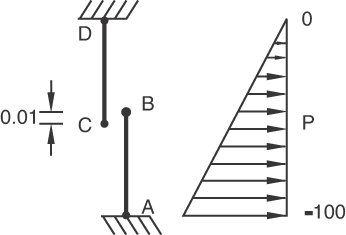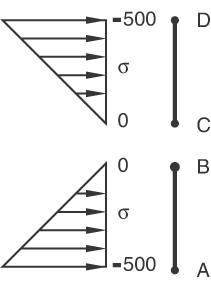Elements tested
CAX8P
CPE8P
ProductsAbaqus/Standard Elements testedCAX8P CPE8P Features testedSmall-sliding contact pair Problem description Model:The out-of-plane thickness for all elements is 0.5. Material:The elastic properties of the soil are Young's modulus = 1 × 108 and Poisson's ratio = 0.0. The permeability of the soil = 1 × 10−4. The initial void ratio = 1.0 for all tests. Boundary conditions:In all tests, nodes are restrained in the 1-direction. Analysis testsThere are four different tests. Initial conditions testThis test verifies that the initial pore fluid pressure procedure works with a contact pair. All nodes in the model are initialized to a pore pressure of −50.0. Consolidation testThe consolidation test verifies that the contact pair procedure works properly with the transient soils consolidation procedure. The test is essentially a one-dimensional problem where two surfaces are brought together at a constant rate, as shown in Figure 2. Point A in the figure corresponds to nodes 1, 5, and 2; point B corresponds to nodes 4, 7, and 3; and so on. As points C and B move toward each other, fluid rushes out through points A and D. This gives rise to a compressive stress state in the soil segments AB and CD. A pore pressure field develops to balance out the effective stresses. Steady-state testThe steady-state test verifies that the contact pair procedure works properly with soil consolidation procedure. The problem is the same one that is modeled in the consolidation test. There is zero stress and zero pore pressure at steady state; therefore, it is necessary to use solution controls to avoid convergence difficulties as a result of the fact that both the time average force and the force residuals are practically zero. Interference testThe interference test verifies that a combination of interface overclosure and pore pressure gradient is handled correctly by the contact pair procedure. The test is essentially a one-dimensional problem where two surfaces start with an interference fit and a pore pressure gradient exists across the two bodies. The steady-state equilibrium is sought. Results and discussionMost of the input files used for these tests employ an unsymmetric equation solver. Using the unsymmetric solver improves convergence in steady-state analyses. Initial conditions testThe pore pressure at every node should be −50.0. Consolidation testFrom Darcy's law we find that during the first step of the analysis the effective stress profile is as shown in Figure 4. From equilibrium of tractions we find that the pore pressure distribution is as shown in Figure 5. After the surfaces have stopped moving toward each other, the stresses and pore pressure quickly drop to zero. This is modeled in the second step of the analysis. Steady-state testThe steady-state result is zero stress and zero pore pressure. Interference testThis problem can be analyzed as a linear superposition of two states, as shown in Figure 6. Input files
Figures     | |||||||